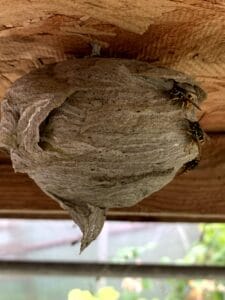Wasp nest treatment and removal in Orpington, London borough of Bromley, Sidcup, Swanley
We are so confident in our treatment for wasp nests that it is guaranteed. We commit to a free return service for any problems that may arise (24 hours from after the time of treatment has elapsed).
If you reside in Orpington, London borough of Bromley, Sidcup, Biggin Hill, Swanley and have a pest problem I try to attend same day.
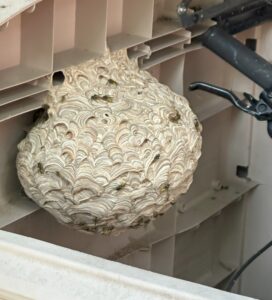
Wasp Nest in Garden shed
Why do we treat wasp nests?
One of the reasons we treat is for the fear of painful stings.
Apart from the discomfort of wasp stings there is also a possibility of an allergic reaction.
A Professional Pest control exterminator such as myself take that risk away by putting our self in the firing line. There are many company's available to do this and you can find some on the British pest control association website and the NPTA (National Pest Technician Association) website. You will find me on the NPTA members area under Kent or if you have clicked the link provided I am about 3 quarters of the way down the page.
But realistically because I have the correct equipment, personal protective clothing and proper training it is much safer for me to do it than you.
It is advisable for most people with a wasp problem to seek professional help.
What do wasp nests look like?
It is very common to see golf ball shaped objects hanging in the loft or garden shed ceilings.
This golf ball sized nest is what a wasp nest looks like in its early life.
Often creamy white in colour a live wasp nest will have workers visibly crawling on the outside.
These golf balls in the winter time can be the sign of a failed nest or at the beginning of the season could indicate a new live one.
Where do wasps build nests?
Queen wasps will always build nests in areas that are protected from the elements and easily defendable.
This can be under a tile on your roof which leads into the loft space. It could also be in cracks or crevices and even an air brick in the wall.
They will also build in places like garden sheds or garages. This is because the protection of a garden shed or garage and also provides warmth from very little sun to aid early growth.
Wasps will also build nests in the ground. These are more often the most aggressive type. When you approach them, ground vibration from footsteps is enough to trigger a defensive stance agitating the nest. Normally people miss the flight activity of the wasp nest in the ground and it's not until being attacked that they realise there is a problem.
Why do wasps build nests?
The two most common types in the UK are Vespula Germanica and Vespula Vulgaris.
Nests are built in order to protect their eggs and larvae. In early spring the queen will choose a location that is sheltered from the elements and that is easily defensible. This can include trees, shrubs, lofts, and even the eaves of your home.
Once the queen has found a suitable location, she will start building the nest. She does this by collecting wood fibers and mixing them with saliva to create a papery substance. This substance is then used to build the walls of the nest.
Wasps go on sight much like pigeons and you can observe them following the same flight path backwards and forwards.
Do wasp nests need to be removed?
Nests pose various dangers for several reasons. Firstly, any disturbance to a nest may agitate the wasps inside leading to multiple stings from agitated wasps. This becomes especially perilous for individuals allergic to stings, possibly resulting in anaphylactic shock.
Secondly, the presence of wasp nests can result in property damage. For instance, if a nest is situated in the eaves of your home, wasps might find their way indoors through small gaps, causing harm to insulation.
Popping into a loft can be distressing, particularly if you are unsure how to address the situation or allergic to stings.
Ultimately, if a nest remains unaddressed, the resident wasps will continue reproducing, causing the nest to grow larger and more challenging to manage as the season progresses. When the queen eventually departs the nest to hibernate, new emerging queens face a unique challenge. In normal circumstances, these would be eliminated, as there can only be one ruler of the nest. However, these emerging queens must hastily seek a location for hibernation, perpetuating the life cycle.
If a nest is in a location that has no bearing on your day to day life it could be left to die off naturally during the 1st frosts.
Wasp nest removal is a job that should only be carried out by a trained professional.
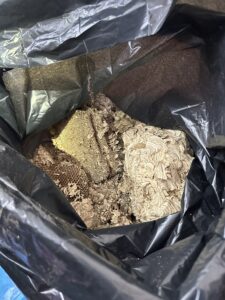
Wasp Nest taken away
Attempting to remove a nest yourself can be extremely dangerous.
The key to successful safe treatment is using quality specialist tools for the job and personal protective equipment. Any professional pest control expert should have this as their basic kit.
Identifying what we are dealing with.
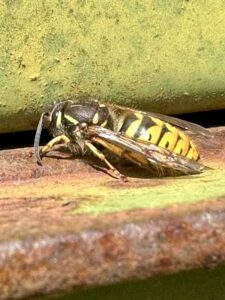
wasp in the sun
Prime target pest control will use a variety of methods to remove or treat the nest, depending on its location and size. We will also confirm what we are dealing with is wasps.
At the very starts of the insect season honey bee's swarm and people often think its a wasp nest.
Bee's also being black and yellow with a similar body shape at first glance could easily be mistaken for wasps.
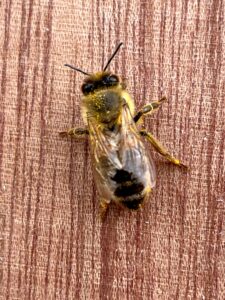
Honey Bee on plywood
One giveaway on closer inspection is that bee's have a furry appearance to the thorax (this is the section between the head and the abdomen).
Another difference is the legs on bee's body look like they hang when they are in flight. Unlike a wasp which legs are closer to the body.
Toward the end of the season another type of bee emerges and that is the ivy bee. These bees swarm Ivy flowers and may be seen in great numbers emerging from lawns that are the right sand and soil consistency.
Even though the Ivy bees can be observed in great numbers they are in fact a solitary bee.
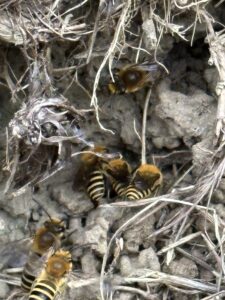
Ivy Bee
It is important to correctly identify what we are dealing with as we DO NOT treat bee's under any circumstances.
Here in the UK we also now have another threat which is the Asian hornet. These are far more aggressive than your average wasp. You should not attempt to kill these,instead call the Great British Non Native Species Secretariat. We as pest controllers are currently not allowed to treat these and any company telling you otherwise is not correct.
A little about the wasp nest treatment
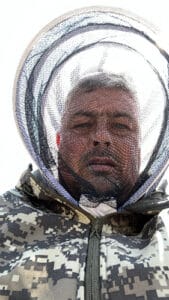
Steve on a hot day wasp nest ready
Very often referred to as wasp nest removal, it is in fact more often a wasp nest treatment.
The safest method where possible is to treat a nest from outside of the property. It can be extremely hot in a loft in the summer months especially when wearing a protective suit.
We have the proper personal protective clothing to assure we don't get stung in the process, but it is still far safer to treat from outside where possible.
In most cases we use a specialized sprayer which pumps dry powder based insecticide. This is pumped into the nest entrance at around 2-3 bar of pressure . The pressure of the powder then blasts into the entrance which is normally only inches away from where you can see them traveling in and out.
The wasps that are inside the nest will then be coated in the insecticide dust. They then take the dust inside and clean each other off which kills them internally.
The wasps on the outside of the nest will not want to enter. The fine dust insecticide that is used creates an effective barrier. All insects have a row of breathing holes called spiracles along the lateral line of their body. These fine breathing holes could easily become clogged which is why they avoid the fine powder. The wasps outside of the nest will either join another local nest or die. Without the nest and queen to serve the wasp has no purpose.
In rare cases we may do a physical removal of the nest while it is still live. I do not normally take this action as it is far safer with the dry powder spray and the end result is the same.
Why do we treat from outside where possible ?
Some lofts are boarded which makes it easier to navigate, but also a lot of lofts are not. However protective suits not only make you hot but they also decrease visibility somewhat. This makes having safe footing on beams a precarious task especially when in carrying equipment and in a suit.
Inside a loft we are all guilty of using that valuable commodity which is space. This can make it also make harder to negotiate to where the nest is.
Another thing is some lofts have lighting and others do not. There are benefits to having lighting in that the wasps will be drawn to the light away from someone entering the loft. This in no way ensures that you will not be stung but it is an added distraction.
If there is no lighting and you have to take a torch into a loft the first thing the wasps are attracted to is the open loft hatch. They confuse that light with the exit to the nest. That is because that is the brightest light source. But as soon as you enter with a torch switched on your torch will become the brightest thing.
What happens after treatment ?
After treating the nest, all activity should cease within 24 hours. Remaining wasps will either go to find another queen or die as they no longer have a purpose.
We are so confident in our wasp nest treatment that if any issues arise after this 24 hour period, we will arrange a free return service.
A nest, once exterminated, will never be utilized again. Similarly, a nest that has naturally died off due to cold weather will not be reused.
In conclusion, if a wasp nest is present on your property and you would like it promptly dealt with by a friendly local technician. Please call Steve for any of the following areas: Orpington, London borough of Bromley, Sidcup, Biggin Hill, Swanley. It's crucial to treat a nest quickly for your safety and the safety of your family.
We are a genuine local company based in poverest that aims to attend on the same day if possible.

